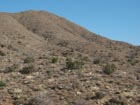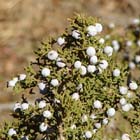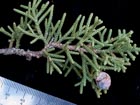
Small tree in the northern Santa Rosa Mountains, CA [C.J. Earle, 2002.03.08].

Trees on the landscape at Box Canyon, California [C.J. Earle, 2012.03.08].

A large single tree along CA 22 about 15 mi W of Borrego Springs [C.J. Earle, 2004.04.09].

Seed cones on the above small tree [C.J. Earle, 2002.03.08].

Twig, foliage and mature cone. Scale is in mm [C.J. Earle, 2014.01.17].

Foliage and current-year cones on the above large tree [C.J. Earle, 2004.04.09].

Juvenile foliage on a tree at Rancho Santa Ana Botanic Garden, CA [C.J. Earle, 2004.04.13].

Bark on the above large tree - about 40 cm diameter [C.J. Earle, 2004.04.09].

Conservation Status

Juniperus californica
Carrière 1854
Common names
California juniper, California white cedar, sweetberry cedar (Peattie 1950), huata, cedro (Adams 1993), desert white cedar, Cedros Island juniper (Zanoni and Adams 1979). See huntergatherer (accessed 2023.06.23) for its names in dozens of aboriginal languages.
Taxonomic notes
Syn: Sabina californica (Carrière) Antoine 1857; J. pyriformis Lindley 1855; J. cerrosianus Kellogg 1859; J. cedrosiana Kellogg 1860; J. occidentalis W.J. Hooker 1868 (Zanoni and Adams 1979).
Description
"Shrubs or trees dioecious (rarely monoecious), to 8 m, multistemmed (seldom single-stemmed); crown rounded. Bark gray, exfoliating in thin strips, that of smaller and larger branchlets smooth. Branches spreading to ascending; branchlets erect, terete, about as wide as length of scalelike leaves. Leaves light green, abaxial glands elliptic to ovate, conspicuous, exudate absent, margins denticulate (at 20´); whip leaves 3-5 mm, not glaucous adaxially; scalelike leaves 1-2 mm, not overlapping, or rarely overlapping by ca. 1/5 their length, generally flattened, apex acute to obtuse, closely appressed. Seed cones maturing in 1 year, of 1 size, with straight peduncles, globose, (7)9-10(13) mm, bluish brown, glaucous, fibrous, with 1(2) seeds. Seeds 5-7 mm" (Adams 1993). See García Esteban et al. (2004) for a detailed characterization of the wood anatomy.
Distribution and Ecology
USA: S Nevada, California, W Arizona; Mexico: Baja California Norte, incl. Isla de Cedros, Isla Guadalupe, Sierra Juarez, Sierra San Pedro Martir, Sierra San Borja and Sierra de Calamujue y San Luis, at (270-)750-1200(-1600) m elevation on dry, rocky slopes and flats (Zanoni and Adams 1979, Adams 1993). Hardy to Zone 8 (cold hardiness limit between -12.1°C and -6.7°C) (Bannister and Neuner 2001).
Distribution of the primary serrate-leaf-margin Juniperus taxa of western North America; J. californica shown in yellow. Click on any marker for more information and a link to the source.
Occurs with piñon (typically Pinus monophylla) in woodlands and with Joshua-tree (Yucca brevifolia) in drier areas; as such, it is the most drought-tolerant juniper in the region (Little 1980). See also Thompson et al. (1999).
Remarkable Specimens
American Forests (1996) reported the largest tree is in Colusa County, California: iameter 76 cm, height 10 m, crown spread 12 m.
Ethnobotany
Observations
I have seen it at Joshua Tree National Park in the Mojave Desert of California, near Tejon Pass along Interstate 5 N of Los Angeles, and along CA 22 about 15 mi W of Borrego Springs. It seems to be generally common in the interior desert of southern California.
Remarks
"Although two races, differing in volatile leaf oils, were described by Vasek and Scora (1967) and confirmed by Adams et al. (1983), no differences were found in volatile wood oils (Adams 1987). To date, no morphological characters appear to be correlated with the chemical races. No other Western Hemisphere species of Juniperus has been found to have leaf-oil races" (Adams 1993).
Citations
Adams, Robert P. 1993. Juniperus. Flora of North America Editorial Committee (eds.): Flora of North America North of Mexico, Vol. 2. Oxford University Press. This document is available online. Go to http://www.efloras.org, click on "Flora of North America," and search for "Juniperus."
American Forests 1996. The 1996-1997 National Register of Big Trees. Washington, DC: American Forests.
Carrière, E.A. 1854 Description d'une nouvelle espèce de Genévrier, Juniperus californica. Carr. Rev. Hort. 4(3):352-353.
See also
Farjon (2005) provides a detailed account, with illustrations.
Lanner (1999) does likewise.








